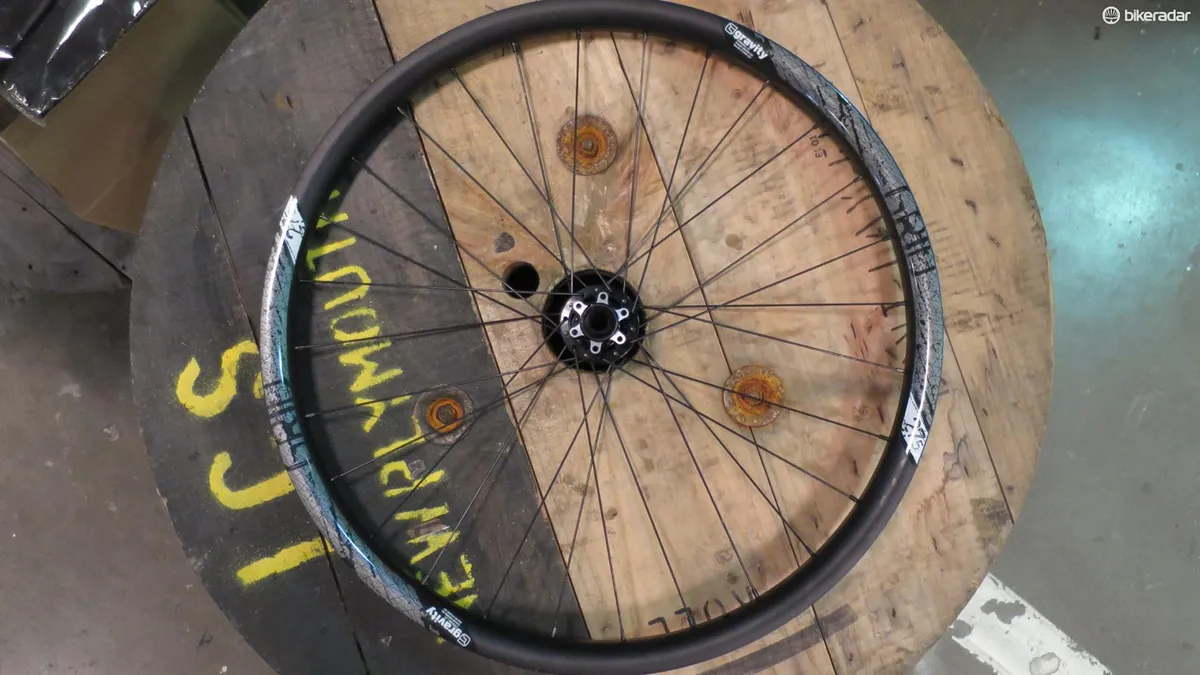With the humdrum of Sea Otter eating up journos' time, Gravity – FSA's, er, gravity orientated brand – thankfully gave BikeRadar a sneak peek at its new line-up of Grid products, which should be hitting shop floors in late May/June.
The Pacific Northwest-born Grid lineup is built for trail and enduro riders. The mid-level alloy componentry has been developed with the aim of combining lightness and strength without breaking the bank.
Grid MegaExo Cranks

First up are these new cranks, which use FSA’s MegaExo crank/axle/BB system. The hollow-forged AA 6066 arms come in 170 and 175mm lengths, and can be purchased with either single 30, 32 or 34t rings or 24/34 and 22/36 double options. The cranks are forged from a single block of metal for maximum strength-to-weight. There’s an anodised finish with graphics laid over the top, and a steel pedal insert to prevent cross-threading to finish the package. Claimed weight for the cranks is a fair 785g.
The single ring option comes with Gravity's Megatooth ring, with the now ubiquitous narrow-wide profile, but with longer teeth for maximum chain retention.
Bar and stem

Long gone are 24.5mm handlebars, with ‘OS’ standard 31.8mm now the norm. Bigger is better in the eyes of many though, and Gravity is following through with its 35mm diameter bar/stem Grid combo.
The stem is 3D forged and then CNC machined to get its finish, and comes in 35 and 50mm lengths – no barge-like steering with these guys.
Like a number of current stems, there’s a no-gap faceplate for added stiffness and strength – with the bars in place, the top bolts pull the face place snug to the stem, and the bottom two take up the rest of the slack. At the steerer tube, opposing bolts help spread forces more equally.

Grid’s new bar is a 6061 alloy affair. The bar is double butted and tapered for weight and comfort, and comes in 760 and 800mm widths. The 35mm diameter matches the stem, while there’s a 20mm rise, eight-degree backsweep and five-degree upsweep.
Given that you can’t make a narrow bar wider, but you can chop down a wide one, we’d go for the 800mm option every time – markings on the bar should help with measuring.
The stem comes in at a claimed 135g (for the 35mm model) and the bars 303g (760mm).
Grid chainguide

Despite the reliability of narrow-wide and clutch controlled drivetrains, plenty of riders still like the added security of a chain device. Grid’s differs from most thanks to its easily adjustable upper and lower guides.
By removing the pin from the guides, they can easily be height adjusted or swung out of the way for easier maintenance. With most guides having somewhat fiddly adjustment, being able to quickly move them out of the way should make life easier after a bent chainring or, if you’re a pro at least, you want to swap to a bigger ring for a race or event.
The guide mounts via an ISCG 05 attachment, and there’s an adapter for threaded BB mounting. The guides and bashguard are polycarbonate and attach via chromoly bolts – the bashguard is removable and replacable.
The chainguide comes in two versions – 28-34t and 34-38t – and is claimed to weigh 160g.
Grid wheelset

Gravity has a new wheelset to go with its bars, stems and cranks. The wheels feature a 27mm internal width ‘ASYM’ rim, which in our experience leads to improved tyre profiles with bigger rubber. Externally the rim is 31mm wide and it’s 25mm deep too.
Perhaps the bigger story with the rim is that it has a 4mm offset spoke bed. In the front wheel the offset is away from the disc-side of the wheel. Dishing on the front wheel means that adding this 4mm offset means better triangulation between rim, spoke and hub, and more even spoke tension side to side, theoretically giving a stiffer wheel (Gravity claims a 25 percent increase in front wheel stiffness).
At the back, the rim is offset the other way – as the cassette encroaches further towards the centre of the hub than the disc mount – but 4mm can’t take up all the difference, so there’s more differential in spoke tension between each side, Nonetheless, Gravity says it's achieved a 17 percent increase in stiffness.
The wheels themselves are both handbuilt with 28 spokes. The rims are tubeless compatible and are hookless too. The front wheel is designed for 15mm axles, while the rear is 135- and 142-compatible. Fans of both wheel sizes are catered for with the 650b version coming in at a claimed 1850g and the 29er at 1980g.
















